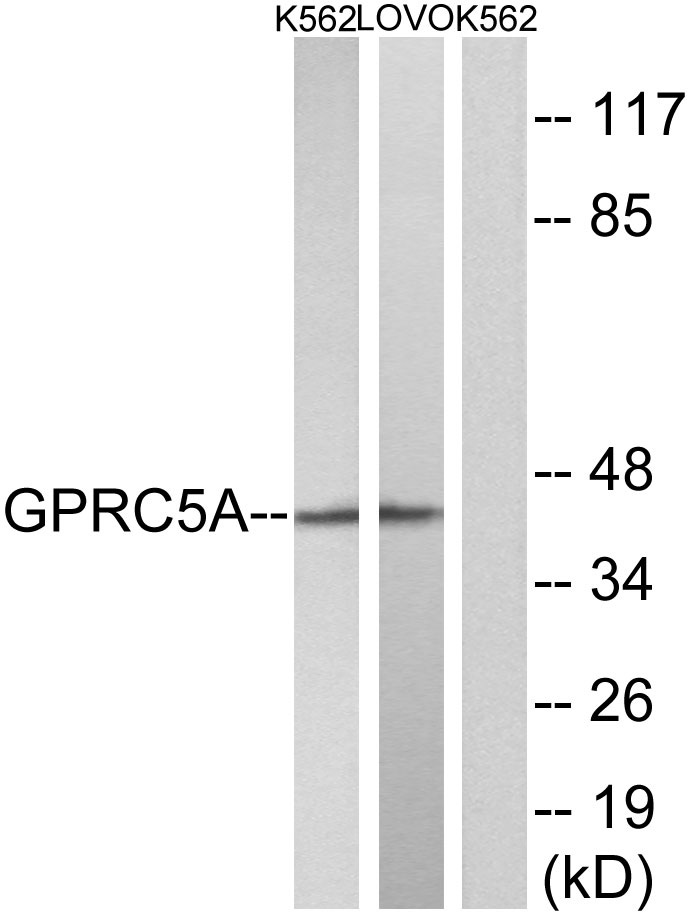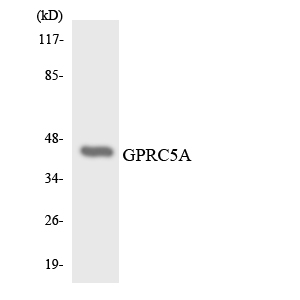RAI3 Polyclonal Antibody
- Catalog No.:YT3995
- Applications:WB;ELISA
- Reactivity:Human;Mouse;Rat
- Target:
- RAI3
- Gene Name:
- GPRC5A
- Protein Name:
- Retinoic acid-induced protein 3
- Human Gene Id:
- 9052
- Human Swiss Prot No:
- Q8NFJ5
- Mouse Swiss Prot No:
- Q8BHL4
- Immunogen:
- The antiserum was produced against synthesized peptide derived from human GPRC5A. AA range:140-189
- Specificity:
- RAI3 Polyclonal Antibody detects endogenous levels of RAI3 protein.
- Formulation:
- Liquid in PBS containing 50% glycerol, 0.5% BSA and 0.02% sodium azide.
- Source:
- Polyclonal, Rabbit,IgG
- Dilution:
- WB 1:500 - 1:2000. ELISA: 1:10000. Not yet tested in other applications.
- Purification:
- The antibody was affinity-purified from rabbit antiserum by affinity-chromatography using epitope-specific immunogen.
- Concentration:
- 1 mg/ml
- Storage Stability:
- -15°C to -25°C/1 year(Do not lower than -25°C)
- Other Name:
- GPRC5A;GPCR5A;RAI3;RAIG1;Retinoic acid-induced protein 3;G-protein coupled receptor family C group 5 member A;Orphan G-protein-coupling receptor PEIG-1;Retinoic acid-induced gene 1 protein;RAIG-1
- Observed Band(KD):
- 40kD
- Background:
- This gene encodes a member of the type 3 G protein-coupling receptor family, characterized by the signature 7-transmembrane domain motif. The encoded protein may be involved in interaction between retinoid acid and G protein signalling pathways. Retinoic acid plays a critical role in development, cellular growth, and differentiation. This gene may play a role in embryonic development and epithelial cell differentiation. [provided by RefSeq, Jul 2008],
- Function:
- function:Unknown. This G-protein coupled receptor could be involved in modulating differentiation and maintaining homeostasis of epithelial cells. The comparable expression level in fetal lung and kidney with adult tissues suggests a possible role in embryonic development and maturation of these organs. This retinoic acid-inducible GPCR provide evidence for a possible interaction between retinoid and G-protein signaling pathways.,induction:By all-trans retinoic acid (ATRA).,similarity:Belongs to the G-protein coupled receptor 3 family.,subcellular location:Localized in the plasma membrane and perinuclear vesicles.,tissue specificity:Expressed at high level in fetal and adult lung tissues. Constitutively expressed in fetal kidney and adult placenta, kidney, prostate, testis, ovary, small intestine, colon, stomach, and spinal chord at low to moderate levels. Not detectable in fetal heart,
- Subcellular Location:
- Cell membrane ; Multi-pass membrane protein . Cytoplasmic vesicle membrane ; Multi-pass membrane protein . Localized in perinuclear vesicles, probably Golgi-associated vesicles. .
- Expression:
- Expressed at high level in fetal and adult lung tissues but repressed in most human lung cancers (PubMed:9857033, PubMed:18000218). Constitutively expressed in fetal kidney and adult placenta, kidney, prostate, testis, ovary, small intestine, colon, stomach, and spinal cord at low to moderate levels. Not detectable in fetal heart, brain, and liver and adult heart, brain, liver, skeletal muscle, pancreas, spleen, thymus, and peripheral leukocytes. According to PubMed:10783259, expressed at low but detectable level in pancreas and heart.
GPRC5A Is a Negative Regulator of the Pro-Survival PI3K/Akt Signaling Pathway in Triple-Negative Breast Cancer. Frontiers in Oncology Front Oncol. 2021 Feb;10:3448 IHC Mouse 1:1000 MDA-MB-231-MCS-Xenograft,GPRC5A-Xenograft
- June 19-2018
- WESTERN IMMUNOBLOTTING PROTOCOL
- June 19-2018
- IMMUNOHISTOCHEMISTRY-PARAFFIN PROTOCOL
- June 19-2018
- IMMUNOFLUORESCENCE PROTOCOL
- September 08-2020
- FLOW-CYTOMEYRT-PROTOCOL
- May 20-2022
- Cell-Based ELISA│解您多样本WB检测之困扰
- July 13-2018
- CELL-BASED-ELISA-PROTOCOL-FOR-ACETYL-PROTEIN
- July 13-2018
- CELL-BASED-ELISA-PROTOCOL-FOR-PHOSPHO-PROTEIN
- July 13-2018
- Antibody-FAQs
- Products Images

- Western blot analysis of lysates from K562 and LOVO cells, using GPRC5A Antibody. The lane on the right is blocked with the synthesized peptide.

- Western blot analysis of the lysates from K562 cells using GPRC5A antibody.



